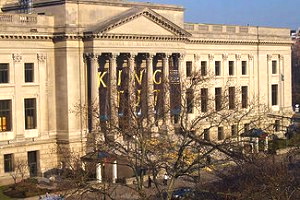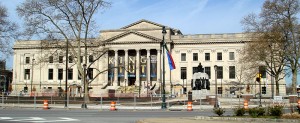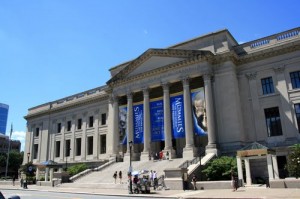Franklin Institute

Titanic Passenger: “The Unsinkable” Molly Brown
Actress portraying Titanic passenger (and survivor) Margaret “Molly” Brown (aka: “The Unsinkable”) details a small slice of what life was like aboard the Titanic on it’s fateful maiden voyage. Actor portrayals of passengers are a regular feature of The Franklin Institute’s “Titanic: The Artifact Exhibition” open now through April 7th, 2013. Go to www.fi.edu for ticket information.
Franklin Institute
The Franklin Institute (named after the noted American scientist and statesman Benjamin Franklin) is a museum in Philadelphia, Pennsylvania, and one of the oldest centers of science education and development in the United States, dating to 1824. The Institute also houses the Benjamin Franklin National Memorial.
History
On February 5, 1824, Samuel Vaughn Merrick and William H. Keating founded The Franklin Institute of the State of Pennsylvania for the Promotion of the Mechanic Arts. The museum began in 1825 in its original building at 15 South 7th Street (now the site of the Atwater Kent Museum) and moved into its current home on the Benjamin Franklin Parkway, near that parkway’s intersection with 20th Street, over 100 years later, in 1934. Funds to build the new Institute and Memorial on the Parkway came from the Poor Richard Club, the City Board of Trust, the Benjamin Franklin Memorial, Inc., and The Franklin Institute. John T. Windrim’s original design was a completely square building surrounding the Benjamin Franklin Statue, which had yet to be built. Despite the effects of the Great Depression, the Benjamin Franklin Memorial, Inc. raised $5 million between December 1929 and June 1930. Only two of the four wings envisioned by Windrim were built. The Franklin Institute was integrated in 1870, when Philadelphia teacher and activist Octavius Catto was admitted as a member.
Many scientists have demonstrated groundbreaking new technology at The Franklin Institute. From September 2 to October 11, 1884, it hosted the International Electrical Exhibition of 1884, the first great electrical exposition in the United States. Nikola Tesla demonstrated the principle of wireless telegraphy at the institute in 1893. The world’s first public demonstration of an all-electronic television system was later given by Philo Taylor Farnsworth on August 25, 1934.
Front steps as seen from the adjacent Moore College
On March 31, 1940, press agent William Castellini issued a press release stating that the world would end the next day. The story was picked up by KYW, which reported, “Your worst fears that the world will end are confirmed by astronomers of Franklin Institute, Philadelphia. Scientists predict that the world will end at 3 p.m. Eastern Standard Time tomorrow. This is no April Fool joke. Confirmation can be obtained from Wagner Schlesinger, director of the Fels Planetarium of this city.” This caused a panic in the city which only subsided when The Franklin Institute assured people it had made no such prediction. Castellini was dismissed shortly thereafter.
Succession of Presidents:
- James Ronaldson (1824–1841)
- Samuel V. Merrick (1842–1854)
- John C. Cresson (1855–1863)
- William Sellers (1864–1866)
- John Vaughan Merrick (1867–1869)
- Coleman Sellers (1870–1874)
- Robert Empie Rogers (1875–1878)
- William Penn Tatham (1880–1885)
- Joseph Miller Wilson (1887–1896)
- Dr. Walton Clark (1907–1923)
- Dr. W. Laurence LePage (1958-1967)
- Dr. Athelstan F. Spilhaus (1967–1969)
- Dr. Bowen C. Dees (1970-1981)
- Dr. Joel N. Bloom (1969–1990)
- Dr. James L. Powell (1991-1994)
- Dr. Dennis M. Wint (1995–present)
Capital Campaign
In 2006, The Franklin Institute began fundraising activities for the Inspire Science! capital campaign, a $64.7 million campaign intended to fund the construction of a 53,000 square foot building addition, new exhibits, and upgrades and renovations to the existing Institute building and exhibits.
In 2011, The Franklin Institute received a $10 million gift from Athena and Nicholas Karabots towards the Inspire Science! capital campaign. This gift is the largest gift in the Institute’s history, and put The Franklin Institute within $6 million of the $64.7 million capital campaign goal. The Nicholas and Athena Karabots Pavilion will house not only a $10 million multiroom exhibit on neuroscience, but also a conference center, classroom space, and additional room for traveling exhibitions.
The most recognizable part of The Franklin Institute’s Science Center is The Franklin Institute Science Museum. In the spirit of inquiry and discovery embodied by Benjamin Franklin, the mission of The Franklin Institute Science Museum serves to inspire an understanding of and passion for science and technology learning. Among other exhibits, The Science Museum holds the largest collection of artifacts from the Wright brothers‘ workshop.
Permanent exhibits
- Electricity, which replaced Franklin…He’s Electric in 2010, showcases Franklin’s discovery of electricity and its use in the modern world, including elements such as a sustainable dance floor, and an array of LEDs that turn on in the presence of cell phone signals and other low-power electrical signals. (Electricity and Technology)
- Changing Earth, which opened to the public, along with Electricity, on March 27, 2010, focuses on the powerful forces of air, water, and land and their effect upon the earth, as well as how humans respond to and interact with these forces.
- The Franklin Airshow features The Wright Brothers Aeronautical Engineering Collection, their newly restored Model B Flyer, and a U.S. Air Force 1948 T-33 Shooting Star Jet Trainer. (Aviation and Technology)
- The Giant Heart has been a Philadelphia icon since its opening in 1954. (Biology, Chemistry and Anatomy)
- The Joel N. Bloom Observatory, remodeled in 2006, features five telescopes, including a giant 10″ Zeiss Refractor and four 8″ Meade Reflectors.
- The Sports Challenge is an interactive exhibit that shows the science behind sports. (Physics and Technology)
- The Train Factory has a real, moving train: The Baldwin 60000 steam locomotive. (History, Engineering and Technology)
- Sir Isaac’s Loft, allows visitors to blend art and science into their own masterpiece. (Physics and Art)
- Space Command features real space suits and allows visitors to track their houses, in real time, via satellite. (Astronomy, Technology and Mathematics)
- The Franklin Institute once featured the Foxtrot Papa Boeing 707 as a permanent exhibit. This partial fuselage could easily be seen from the outside of the building and was a remarkable sight in the middle of a major city. But in the 1980s, the aircraft was sold for scrap, much to the dismay of aviation enthusiasts.
- Amazing Machine allows visitors to experience a machine-like environment featuring little-seen pieces from The Franklin Institute’s priceless collection, including Maillardet’s Automaton, believed to have the largest cam-based memory of any automaton of the era.





